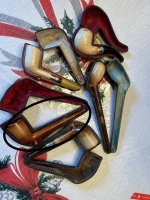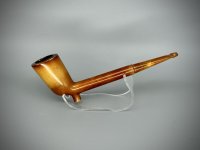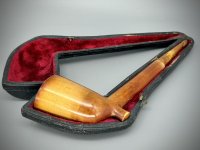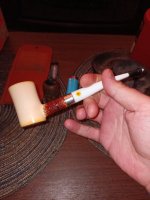So this is where all the nice meer cutties have goneMatch up the relevant pipes to the below picture from my monthly rotation from 2015
View attachment 195298
An Observation of the Coloring of Vintage Meerschaum
- Thread starter Chasing Embers
- Start date
You are using an out of date browser. It may not display this or other websites correctly.
You should upgrade or use an alternative browser.
You should upgrade or use an alternative browser.
SmokingPipes.com Updates
Watch for Updates Twice a Week
Brought this thread back to life rather than start a new one. I own probably 100 or so pre-1920 meers. Many of the earlier ones have partial deep cherry-red areas. What I've found is that zero of these had clean chambers - they were caked, seemingly with no effort ever to clean. Even worse than old briars. So cake does not stop that dark cherry coloring that we would like to reproduce.A warm water flush would have taken care of the taste. But I've been under the impression that cake equals no color. That's the only reason I scrape my meer bowls.
Regarding whale oil - Philippe Bargiel learned his meerschaum-crafting skills working at Sommers. He always treated his meers with whale oil, and when it became illegal he moved to Jojoba Oil. I have read that meers were treated with whale oil to protect the meerschaum from unpleasant smoke flavors. I have not read that it had anything to do with coloring. I've also read that the whale oil was mixed with beeswax. Was the pipe dipped in this mixture by all of the old mater pipe-makers? Was it just dipped in whale oil? Was it treated regularly with one or both? I don't know.
I also read somewhere that an old meer-smoker preferred to begin smoking a whale oil-treated meer as he received it, never adding anything to the bowl. But my thinking is that this will result in zero coloring - my reasoning is that I have quite a few .ca 1900 white meers that were smoked heavily and have no coloring. I assume that most if not all, of the meers from this period, were treated with whale oil before being sold.
I just picked up some Jojuba Oil and plan to treat one of my old (circa 1900) white block meers with it, then smoke it heavily and see what happens. Any ideas on how to treat the stummel before I start?
Some of those were oxblood stained.So cake does not stop that dark cherry coloring that we would like to reproduce.
The ones I'm talking about were not oxblood stained.Some of those were oxblood stained.
If you have examples of meers that you are certain were stained with oxblood, please post. The only one I was able to find was a fuzzy pic of a dark reddish-brown pipe where the entire stummel had been stained.
I've seen a couple that may be what you are describing, but I can't find any photos at the moment. Here are two of mine. The top one had more cherry red before I refurbished it; the bottom, less.


Last edited:
The owner of this pipe may have hoped to get the bricks to turn red eventually. If staining with oxblood he would probably have just gotten it done immediately.


Nice example. Now that I've seen yours I'll go back and dig through mine and see if I have any examples. I'm fairly sure I do not.
It looks like this is what the pipe-maker was going for with the bottom stain area. This is one of my favorite meers.

It looks like this is what the pipe-maker was going for with the bottom stain area. This is one of my favorite meers.

Regarding coloring discs
Here's my 1902 Peterson Patent prior to restoration. It was heavily smoked with a coloring disc stuck in the bottom of the bowl (it was hell to remove).
A moment ago I used a heat gun to melt surface wax, and I buffed it good. I repeated the process several times. Bottom pic shows what the bowl looked like immediately after heating. Center pic shows the result after it cooled down and I buffed the final time.



Here's my 1902 Peterson Patent prior to restoration. It was heavily smoked with a coloring disc stuck in the bottom of the bowl (it was hell to remove).
A moment ago I used a heat gun to melt surface wax, and I buffed it good. I repeated the process several times. Bottom pic shows what the bowl looked like immediately after heating. Center pic shows the result after it cooled down and I buffed the final time.



In the 1700 and 1800's, meerschaum pipes were treated with sperm whale oil known as Spermaceti. Spermaceti is a white waxy substance produced by sperm whales and was formerly used in candles, ointments, and of course meerschaum pipes. I'm not sure if those meerschaum pipes were dipped like the carvers do today when dipping pipes in beeswax, or if the spermaceti was painted on by a brush.
The purpose of the spermaceti, just like the beeswax, is to coat the pipe. The wax coating is what holds the color in. Meerschaum is very porous, so as the meerschaum naturally wicks out the oils amd tars. The coloring of the pipe comes from the meerschaum trying to wick out those tars and oils, but ultimately can't wick them completely out due to the wax coating on the pipe. As the wax is what holds those tars and oils at the surface which allows us to see the pipe color.
I've read where people have used jojoba oil as well as extra virgin olive oil to coat their pipes. I tried olive oil on one of my pipes, but I haven't noticed it coloring any faster than the pipes I have re-waxed with beeswax. It gives the pipe a nice shine, but I've yet to notice a difference between it and using beeswax.
Nice selection of meerschaums. I'm jealous.
The purpose of the spermaceti, just like the beeswax, is to coat the pipe. The wax coating is what holds the color in. Meerschaum is very porous, so as the meerschaum naturally wicks out the oils amd tars. The coloring of the pipe comes from the meerschaum trying to wick out those tars and oils, but ultimately can't wick them completely out due to the wax coating on the pipe. As the wax is what holds those tars and oils at the surface which allows us to see the pipe color.
I've read where people have used jojoba oil as well as extra virgin olive oil to coat their pipes. I tried olive oil on one of my pipes, but I haven't noticed it coloring any faster than the pipes I have re-waxed with beeswax. It gives the pipe a nice shine, but I've yet to notice a difference between it and using beeswax.
Nice selection of meerschaums. I'm jealous.
That all makes sense - thanks for posting. I'm still not understanding the 100-yr old almost-white meers that were smoked heavily, or the ones like the 1902 Pete above that only show coloring in a particular area. I've also read that some old smokers thought the best coloring came from meers where they added no wax, so the pipe was only coated with the whale oil that the pipe-maker dipped it in.In the 1700 and 1800's, meerschaum pipes were treated with sperm whale oil known as Spermaceti. Spermaceti is a white waxy substance produced by sperm whales and was formerly used in candles, ointments, and of course meerschaum pipes. I'm not sure if those meerschaum pipes were dipped like the carvers do today when dipping pipes in beeswax, or if the spermaceti was painted on by a brush.
The purpose of the spermaceti, just like the beeswax, is to coat the pipe. The wax coating is what holds the color in. Meerschaum is very porous, so as the meerschaum naturally wicks out the oils amd tars. The coloring of the pipe comes from the meerschaum trying to wick out those tars and oils, but ultimately can't wick them completely out due to the wax coating on the pipe. As the wax is what holds those tars and oils at the surface which allows us to see the pipe color.
I've read where people have used jojoba oil as well as extra virgin olive oil to coat their pipes. I tried olive oil on one of my pipes, but I haven't noticed it coloring any faster than the pipes I have re-waxed with beeswax. It gives the pipe a nice shine, but I've yet to notice a difference between it and using beeswax.
Nice selection of meerschaums. I'm jealous.
Still looking forward to seeing a modern meer that one of you has gotten to color like the pipes of old.
The ones I've seen oxblood stained faded from the heat of smoking leaving only the shank and the base of the stummel stained. A phenomenon I'm witnessing currently on a brown octopus meerschaum. Coming from carvers, the wax just prevents scratching the soft material. Being natural sponges, meerschaum will color fine without waxing. Even that heavily smoked personal pipe of Baki is showing no sign of red.The ones I'm talking about were not oxblood stained.
If you have examples of meers that you are certain were stained with oxblood, please post. The only one I was able to find was a fuzzy pic of a dark reddish-brown pipe where the entire stummel had been stained.
I've seen a couple that may be what you are describing, but I can't find any photos at the moment. Here are two of mine. The top one had more cherry red before I refurbished it; the bottom, less.


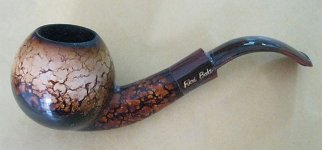
Last edited:
Here's an 1891 bone-white meer made by Charles Peterson himself - well-smoked, with a 'coloring' disc. Maybe beeswax/whale oil wasn't required for coloring, but SOMETHING was.




That all makes sense - thanks for posting. I'm still not understanding the 100-yr old almost-white meers that were smoked heavily, or the ones like the 1902 Pete above that only show coloring in a particular area. I've also read that some old smokers thought the best coloring came from meers where they added no wax, so the pipe was only coated with the whale oil that the pipe-maker dipped it in.
Still looking forward to seeing a modern meer that one of you has gotten to color like the pipes of old.
Chasing Embers noted the same thing I was going to say, which is that the pipes stained in ox blood will fade and return to white. Though that takes a lot of years and a lot of smokes. I have a Yanik giant apple that was dipped in yellow beeswax and was a bright yellow color upon arrival. However, as I've smoked it over the years that yellow color is fading and I'm beginning to see white coming through. So, it's possible that those deep ox blood pipes that are only stained around the base of the stummel and shank were probably so heavily smoked that they've returned to their natural color. I think of it as reverse coloring.
Chasing Embers also noted that meers will color without beeswax, and that is true. It's my opinion that pipes with wax will hold their color better overtime but that's just my opinion. I could be completely wrong though as I don't have any meers without wax on them.
I don't believe any of the ones I've shown were stained with oxblood. Too many smokers have mentioned the deep cherry red occurring from smoking, not from staining. Not saying yours and Chasing Embers pipes aren't stained with oxblood - I have no idea - but mine aren't.Chasing Embers noted the same thing I was going to say, which is that the pipes stained in ox blood will fade and return to white. Though that takes a lot of years and a lot of smokes. I have a Yanik giant apple that was dipped in yellow beeswax and was a bright yellow color upon arrival. However, as I've smoked it over the years that yellow color is fading and I'm beginning to see white coming through. So, it's possible that those deep ox blood pipes that are only stained around the base of the stummel and shank were probably so heavily smoked that they've returned to their natural color. I think of it as reverse coloring.
Chasing Embers also noted that meers will color without beeswax, and that is true. It's my opinion that pipes with wax will hold their color better overtime but that's just my opinion. I could be completely wrong though as I don't have any meers without wax on them.
From an 1874 NY Times article:
"The important question of coloring comes up next. He must select one of two ways in which to do it, and before he begins, before even one pipeful of tobacco can be smoked, he must make up his mind as to which he will take. The first is by the use of what is called the “button,” and the second by the “plug.” A wide difference of opinion exists among amateurs and experts in the art as to which is the best. By the first method a meerschaum button, made to fit the lower part of the cavity of the pipe, with four or five small holes bored perpendicularly through it, is placed in the bottom, and upon it the tobacco. The smoke, passing through the button, soon saturates it with the essential oil, or nicotine, and thence it is absorbed into the body or the pipe, which soon acquires that dark cherry-brown color so much admired by connoisseurs. The “plug” method is very much on the same principle. A wad of moist tobacco is placed in the bottom of the pipe, and the tobacco to be smoked is put in loosely on the top. The “plug” must not be taken out until the pipe is fairly colored. It acts as the button does in absorbing the nicotine and transmitting it to the pipe. He decides that he will try the “plug” process, and with great care, moistens a sufficient quantity of tobacco, and after fixing it in its place proceeds to fill up his pipe very carefully. He then gets a match, and taking great pains not to allow the flame to touch the white edges of the virgin meerschaum, begins to smoke. He knows what he is about, evidently, for he smokes his pipe tenderly and considerately. He takes care not to heat it, for he knows that if he does it will never color properly. When the tobacco has burned down to the plug be gently scrapes out the ashes, and, giving it a parting glance of affection, puts it back in its case in order to let it cool off. Half an hour later he smokes it again, and when bedtime comes he takes it up stairs with him and puts it on his dressing table with his watch, so that he can save it in case of fire. And so he continues smoking it a little while each evening, and at last is rewarded by seeing a delicate straw color make its appearance on the bowl on a line with the plug. Then he feels happy. Re polishes his pipe with his handkerchief and shows it to his wife and she expresses a due amount of admiration. And so he goes on until it is of a beautiful cherry-brown from the top of the stem to the middle of the bowl, and he has something to be proud of, and which does him credit as a smoker and the man he bought it of as a manufacturer. "
The brown wax starts fading almost immediately. I've only smoked this Ali 5 times.I have a Yanik giant apple that was dipped in yellow beeswax and was a bright yellow color upon arrival. However, as I've smoked it over the years that yellow color is fading and I'm beginning to see white coming through.
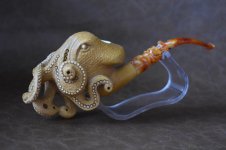


Sounds more like a marketing ploy. I've used the buttons and plugs and those pipes didn't color any more quickly than those without nor was any red color produced, only brown.From an 1874 NY Times article:
Nicotine and tobacco essential oil is yellow, amber, and brown. If not oxblood, some other chemical was introduced to the meerschaum.
Calcined meerschaum can produce reds as well.
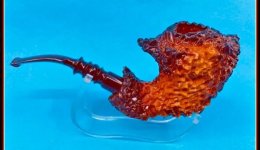
Last edited:
Sounds more like a marketing ploy. I've used the buttons and plugs and those pipes didn't color any more quickly than those without nor was any red color produced, only brown.
Nicotine and tobacco essential oil is yellow, amber, and brown. If not oxblood, some other chemical was introduced to the meerschaum.
Calcined meerschaum can produce reds as well.
View attachment 261549
We'll have to agree to disagree.








